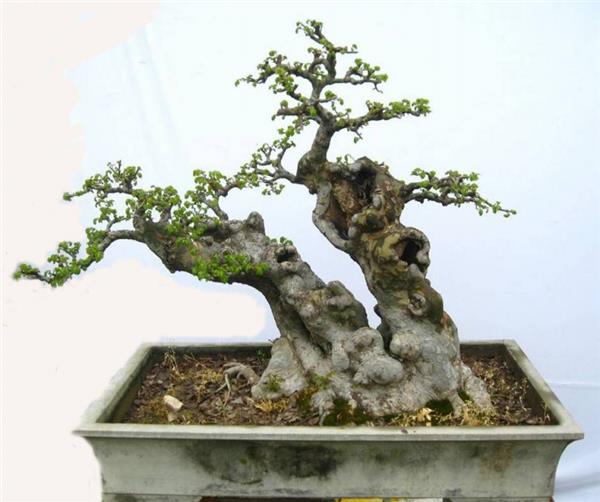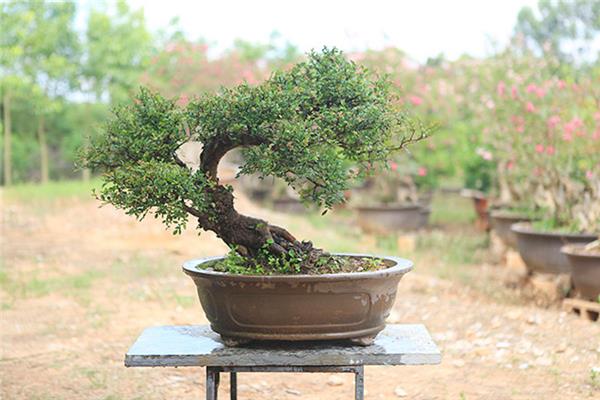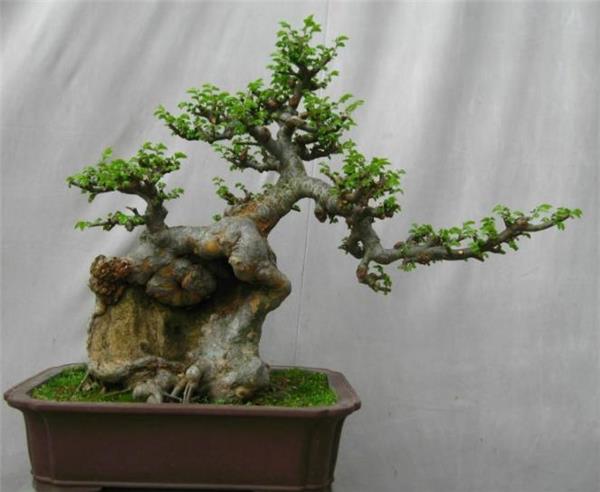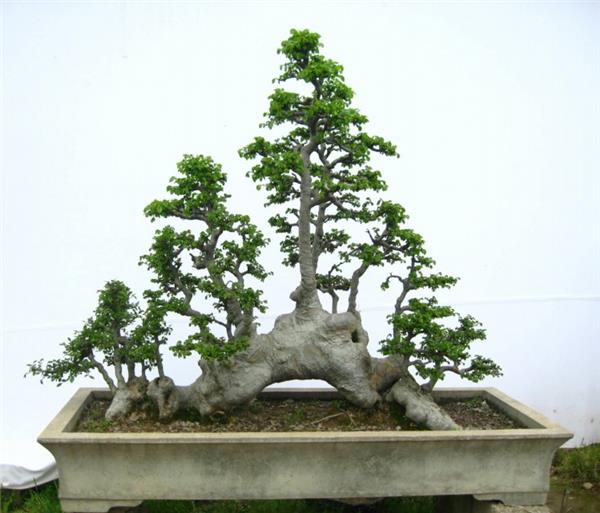The production and maintenance of peat elm bonsai
The original tall tree species into bonsai display at home, can add a stable and generous living, but also can increase a lot of family demeanor, nut elm bonsai of course also has this effect, let's take a look at how to make and maintain a pot of nut elm pile bonsai.

First, the bonsai method of elm
Selection of basin: hammer elm pile scene is generally suitable to use glazed pottery basin, but also can use purple sand pottery basin. The shape of the basin is various, depending on the shape of the tree, and the rectangular basin is the most common. Simple and elegant is the best color.
Use soil: the requirement to the soil is not strict, the adaptability is strong. Pot culture with loose and fertile pastoral soil or rotten leaf soil is suitable, good air permeability and water permeability, is conducive to the development and growth of roots and maintain the luxuriant branches of old piles.
Planting: usually planted before sprouting in February-March in spring, or in autumn. When planting, trim the root properly, cut off the overlong root, and lift it properly. The root system of Ulmus pumila is well developed, which is suitable for bonsai with stone. The planting of attached stone is more difficult, generally, it is necessary to choose the stone with deeper cracks (the cancellous stone can be artificially carved into a stone gap), trim the roots, embed them into the cracks, and tie the main coarse roots with brown silk to make them fixed. When taking root, pay attention not to damage the root system as far as possible, can be covered with moss. After taking root, smear the wet river soil on the outside of the stone, then wrap it with moss, and then plant the root together with the attached stone in the basin soil and carefully maintain it for 3-4 years. When the root system embedded in the stone gap grows fully and fills the stone gap, it can be unbound. At this time, the root system is integrated with the stone, and the stone-attached bonsai of a pot of elm is basically completed.

Second, the moisturizing of bonsai hammer elm downhill pile
It is difficult to keep moisture in the lower mountain pile of pot nut elm, which is characterized by less soil and easy to dry. Pot culture is often placed on the cement ground, for the maintenance of moisture is more difficult. We can also moisturize through the following ways:
The first method, with reference to the principle of the greenhouse, can wrap the stump with a basin with a transparent clinker film to form a "greenhouse", but pay attention to watering.
The second method is to put the flowerpots planted with downhill piles on the ground with soil as far as possible, so that the surface water can also promote the soil in the flowerpots to maintain a certain amount of moisture, and the soil in the flowerpots is not easy to dry, so as to moisturize the tree stump.
Friends here, especially in the northeast, should pay attention. In the north, there is often heating in the room, some potted friends do not have a site, the tree stump is kept at home, we must pay attention to more watering, the heating room is particularly dry, watering must be avoided.

Third, the shaping and pruning technology of elm.
1. The shape and pruning of the trunk: the branch of the elm is hard, and it is generally difficult to hang the three-year-old branch. the shape of the trunk of the elm is reflected in the selection and pruning of the material. The field excavated elm should choose the hairy embryo with more changes in the trunk and good skeleton structure, but avoid choosing the hairy embryo with only one straight trunk without any branches.
two。 Shape pruning of branches: the shape of branches includes the choice of branches, adjustment and control of branch direction and growth, correction of stretching posture, and so on. Generally branch by branch from bottom to top, the main branch should be at a suitable angle with the trunk, evenly distributed, with a certain distance between top and bottom, and the hairy embryo of Ulmus pumila should be trimmed to the trunk or have first-class lateral branches. The extension of the main branch leaves the lateral buds cut lightly, generally leaving buds cross for about two years, so that the extension of the main branch develops in twists and turns.
3. Pruning of the crown: after the shape of the elm forms the basic skeleton, the withered branches, diseased branches, side-by-side branches and endophytic branches are cut off every year during the dormant period. It is appropriate to truncate all levels of lateral branches and leave 20-30cm to promote branching. Remove the overgrown branches and overlapping branches that affect the growth. After sprouting in spring, pay attention to wipe off the dense or erect new shoots in time, leave 2-3 buds on all levels of main and lateral branches, and cultivate the crown step by step.

Of course, in the production and maintenance of nut elm bonsai, we should mainly according to their own ideas and ideas to shape it, so as to make your family's hammer elm bonsai unique and unparalleled.
Related
- Wuhan Hospital Iron Tree Blooming Result Was Instantly Frightened by the Gardener Master
- Which variety of camellia is the most fragrant and best? Which one do you like best?
- What is the small blue coat, the breeding methods and matters needing attention of the succulent plant
- Dormancy time and maintenance management of succulent plants during dormancy
- Minas succulent how to raise, Minas succulent plant pictures
- What are the varieties of winter succulent plants
- How to raise succulent plants in twelve rolls? let's take a look at some experience of breeding twelve rolls.
- Attention should be paid to water control for succulent plants during dormant period (winter and summer)
- Watering experience of twelve rolls of succulent plants
- Techniques for fertilizing succulent plants. An article will let you know how to fertilize succulent plants.



